// One pass through Closure Compiler ADVANCED mode
// Added with statement, golfed switch statement, golfed color array
// I was surprised Closure Compiler didn't touch the switch statement, like, at least convert it into a bunch of conditional statements.
with(C.getContext("2d")){e=2127036416;m=0;fillRect(0,0,256,256);for(n=0;n<64;n++)for(h=[778,14270,12187,1835,3644,62875,35473,6923,3773,37752,47166,45146,28853,640,53425,40146,8339,8348,15633,9942,57113,38901,37027,41799,35575,2137,10669,41772,32252,3453,54650,12369,54321,21547,45634,45332,35478,10516,45297,21292,1043,2569,16059,59670,6263,47330,44146,32967,21056,36156,16047,44387,7700,45629,9103,49275,44957,12590,38606,9639,40503,11332,11193,8505][n],e=e&4294901760|h,p=[h>>8&255,,h&255],fillStyle="#"+["FFE289","E99E45","A55A00","000"][n&3],k=0;k<32*(64-n);k++)l=e&2147483648,e<<=1,l&&(e^=79764919,m=e&255),j=m&130,i=j%4,2<j?p[i]--:p[i]++,fillRect(p[2]&127,p[0]&127,1,1);}
// Background moved to CSS
with(C.getContext("2d")){e=2127036416;m=0;for(n=0;n<64;n++)for(h=[778,14270,12187,1835,3644,62875,35473,6923,3773,37752,47166,45146,28853,640,53425,40146,8339,8348,15633,9942,57113,38901,37027,41799,35575,2137,10669,41772,32252,3453,54650,12369,54321,21547,45634,45332,35478,10516,45297,21292,1043,2569,16059,59670,6263,47330,44146,32967,21056,36156,16047,44387,7700,45629,9103,49275,44957,12590,38606,9639,40503,11332,11193,8505][n],e=e&4294901760|h,p=[h>>8&255,,h&255],fillStyle="#"+["FFE289","E99E45","A55A00","000"][n&3],k=0;k<32*(64-n);k++)l=e&2147483648,e<<=1,l&&(e^=79764919,m=e&255),j=m&130,i=j%4,2<j?p[i]--:p[i]++,fillRect(p[2]&127,p[0]&127,1,1);}
// e<<=1 same as e*=2
with(C.getContext("2d")){e=2127036416;m=0;for(n=0;n<64;n++)for(h=[778,14270,12187,1835,3644,62875,35473,6923,3773,37752,47166,45146,28853,640,53425,40146,8339,8348,15633,9942,57113,38901,37027,41799,35575,2137,10669,41772,32252,3453,54650,12369,54321,21547,45634,45332,35478,10516,45297,21292,1043,2569,16059,59670,6263,47330,44146,32967,21056,36156,16047,44387,7700,45629,9103,49275,44957,12590,38606,9639,40503,11332,11193,8505][n],e=e&4294901760|h,p=[h>>8&255,,h&255],fillStyle="#"+["FFE289","E99E45","A55A00","000"][n&3],k=0;k<32*(64-n);k++)l=e&2147483648,e*=2,l&&(e^=79764919,m=e&255),j=m&130,i=j%4,2<j?p[i]--:p[i]++,fillRect(p[2]&127,p[0]&127,1,1);}
// Semicolon
with(C.getContext("2d")){e=2127036416;m=0;for(n=0;n<64;n++)for(h=[778,14270,12187,1835,3644,62875,35473,6923,3773,37752,47166,45146,28853,640,53425,40146,8339,8348,15633,9942,57113,38901,37027,41799,35575,2137,10669,41772,32252,3453,54650,12369,54321,21547,45634,45332,35478,10516,45297,21292,1043,2569,16059,59670,6263,47330,44146,32967,21056,36156,16047,44387,7700,45629,9103,49275,44957,12590,38606,9639,40503,11332,11193,8505][n],e=e&4294901760|h,p=[h>>8&255,,h&255],fillStyle="#"+["FFE289","E99E45","A55A00","000"][n&3],k=0;k<32*(64-n);k++)l=e&2147483648,e*=2,l&&(e^=79764919,m=e&255),j=m&130,i=j%4,2<j?p[i]--:p[i]++,fillRect(p[2]&127,p[0]&127,1,1)}
// Failed to golf those colors down ;-;
a=n=>["FFE289","E99E45","A55A00","000"][n&3]
b=n=>"FFE289E99E45A55A00000".substr(n%4*6,6)
c=n=>btoa`Q6óÑ=ôN9@ÓM4ÓM4`.substr(n%4*6,6) // <-- there are 2 unprintables somewhere in there
A = [0,1,2,3]
console.log(A.map(n=>a(n)))
console.log(A.map(n=>b(n)))
console.log(A.map(n=>c(n)))
d=n=>`FFE289 E99E45 A55A00 000`.split` `[n&3]
// Let's compress that hunky array of numbers...
[778,14270,12187,1835,3644,62875,35473,6923,3773,37752,47166,45146,28853,640,53425,40146,8339,8348,15633,9942,57113,38901,37027,41799,35575,2137,10669,41772,32252,3453,54650,12369,54321,21547,45634,45332,35478,10516,45297,21292,1043,2569,16059,59670,6263,47330,44146,32967,21056,36156,16047,44387,7700,45629,9103,49275,44957,12590,38606,9639,40503,11332,11193,8505].map(n=>String.fromCharCode(n)).join``
`̊㞾⾛ܫ誑ᬋຽ鍸렾끚炵ʀ킱鳒ₓₜ㴑⛖�韵那ꍇ諷࡙⦭ꌬ緼ൽ핺け퐱含뉂넔誖⤔냱匬Гਉ㺻ᡷ룢걲胇剀贼㺯굣Ḕ눽⎏쁻꾝ㄮ雎▧鸷ⱄ⮹ℹ`.charCodeAt(n)
// And the char at n=20 became 65533 instead of 57113??
with(C.getContext("2d")){e=2127036416;m=0;for(n=0;n<64;n++)for(h=`̊㞾⾛ܫ誑ᬋຽ鍸렾끚炵ʀ킱鳒ₓₜ㴑⛖�韵那ꍇ諷࡙⦭ꌬ緼ൽ핺け퐱含뉂넔誖⤔냱匬Гਉ㺻ᡷ룢걲胇剀贼㺯굣Ḕ눽⎏쁻꾝ㄮ雎▧鸷ⱄ⮹ℹ`.charCodeAt(n),e=e&4294901760|h,p=[h>>8&255,,h&255],fillStyle="#"+["FFE289","E99E45","A55A00","000"][n&3],k=0;k<32*(64-n);k++)l=e&2147483648,e*=2,l&&(e^=79764919,m=e&255),j=m&130,i=j%4,2<j?p[i]--:p[i]++,fillRect(p[2]&127,p[0]&127,1,1)}
// Maybe try replacing that char with \u000? (Nope, editor doesn't like that at all)
with(C.getContext("2d")){e=2127036416;m=0;for(n=0;n<64;n++)for(h=`̊㞾⾛ܫ誑ᬋຽ鍸렾끚炵ʀ킱鳒ₓₜ㴑⛖韵那ꍇ諷࡙⦭ꌬ緼ൽ핺け퐱含뉂넔誖⤔냱匬Гਉ㺻ᡷ룢걲胇剀贼㺯굣Ḕ눽⎏쁻꾝ㄮ雎▧鸷ⱄ⮹ℹ`.charCodeAt(n)||57113,e=e&4294901760|h,p=[h>>8&255,,h&255],fillStyle="#"+["FFE289","E99E45","A55A00","000"][n&3],k=0;k<32*(64-n);k++)l=e&2147483648,e*=2,l&&(e^=79764919,m=e&255),j=m&130,i=j%4,2<j?p[i]--:p[i]++,fillRect(p[2]&127,p[0]&127,1,1)}
// Okay, just check if n is 20 and make an exception.
with(C.getContext("2d")){e=2127036416;m=0;for(n=0;n<64;n++)for(h=n-20?`̊㞾⾛ܫ誑ᬋຽ鍸렾끚炵ʀ킱鳒ₓₜ㴑⛖�韵那ꍇ諷࡙⦭ꌬ緼ൽ핺け퐱含뉂넔誖⤔냱匬Гਉ㺻ᡷ룢걲胇剀贼㺯굣Ḕ눽⎏쁻꾝ㄮ雎▧鸷ⱄ⮹ℹ`.charCodeAt(n):57113,e=e&4294901760|h,p=[h>>8&255,,h&255],fillStyle="#"+["FFE289","E99E45","A55A00","000"][n&3],k=0;k<32*(64-n);k++)l=e&2147483648,e*=2,l&&(e^=79764919,m=e&255),j=m&130,i=j%4,2<j?p[i]--:p[i]++,fillRect(p[2]&127,p[0]&127,1,1)}
// Also, this could work too... (how to do byte comparison properly? Not so knowledgeable about encodings)
+('0x'+btoa`Ó}ß°DØ_AÓ½ÐMÂAðuÔÐ@C÷~üÍÄN@ï@yÓo4@uô öÛOwÛOBÜ=uÛ ú]}÷±y÷@7~;ð{ÓÎ}ÛÐ}ì1BÐ>ÃÀßNuõçn6]xðzÛÝxAuç}ÓwÐ
=Ü@AÝz×ÎûÁ6.öó@»çn4ð=ÂÜ@>·ÔMxmÃÛNÁ_Cß]÷ Û;ôMûØ.8Ø}Û]ý`.substr(n*4,4))
// ES6 template string syntax, easy-peasy.
with(C.getContext`2d`){e=2127036416;m=0;for(n=0;n<64;n++)for(h=n-20?`̊㞾⾛ܫ誑ᬋຽ鍸렾끚炵ʀ킱鳒ₓₜ㴑⛖�韵那ꍇ諷࡙⦭ꌬ緼ൽ핺け퐱含뉂넔誖⤔냱匬Гਉ㺻ᡷ룢걲胇剀贼㺯굣Ḕ눽⎏쁻꾝ㄮ雎▧鸷ⱄ⮹ℹ`.charCodeAt(n):57113,e=e&4294901760|h,p=[h>>8&255,,h&255],fillStyle="#"+["FFE289","E99E45","A55A00","000"][n&3],k=0;k<32*(64-n);k++)l=e&2147483648,e*=2,l&&(e^=79764919,m=e&255),j=m&130,i=j%4,2<j?p[i]--:p[i]++,fillRect(p[2]&127,p[0]&127,1,1)}
// 0x80000000 = 2147483648 = 2**31 = 1<<31
// 0x4C11DB7 = 2127036416 = 4057<<19
// 0xffff0000 = 4294901760
with(C.getContext`2d`){e=4057<<19;m=0;for(n=0;n<64;n++)for(h=n-20?`̊㞾⾛ܫ誑ᬋຽ鍸렾끚炵ʀ킱鳒ₓₜ㴑⛖�韵那ꍇ諷࡙⦭ꌬ緼ൽ핺け퐱含뉂넔誖⤔냱匬Гਉ㺻ᡷ룢걲胇剀贼㺯굣Ḕ눽⎏쁻꾝ㄮ雎▧鸷ⱄ⮹ℹ`.charCodeAt(n):57113,e=e&0xffff0000|h,p=[h>>8&255,,h&255],fillStyle="#"+["FFE289","E99E45","A55A00","000"][n&3],k=0;k<32*(64-n);k++)l=e&1<<31,e*=2,l&&(e^=79764919,m=e&255),j=m&130,i=j%4,2<j?p[i]--:p[i]++,fillRect(p[2]&127,p[0]&127,1,1)}
// Turns out individual x and y vars were better
with(C.getContext`2d`){e=4057<<19;m=0;for(n=0;n<64;n++)for(h=n-20?`̊㞾⾛ܫ誑ᬋຽ鍸렾끚炵ʀ킱鳒ₓₜ㴑⛖�韵那ꍇ諷࡙⦭ꌬ緼ൽ핺け퐱含뉂넔誖⤔냱匬Гਉ㺻ᡷ룢걲胇剀贼㺯굣Ḕ눽⎏쁻꾝ㄮ雎▧鸷ⱄ⮹ℹ`.charCodeAt(n):57113,e=e&0xffff0000|h,x=h&255,y=h>>8&255,fillStyle="#"+["FFE289","E99E45","A55A00","000"][n&3],k=0;k<32*(64-n);k++)l=e&1<<31,e*=2,l&&(e^=79764919,m=e&255),j=m&130,i=j%4,2<j?i?x--:y--:i?x++:y++,fillRect(x&127,y&127,1,1)}
// Reverse loop k
with(C.getContext`2d`){e=4057<<19;m=0;for(n=0;n<64;n++)for(h=n-20?`̊㞾⾛ܫ誑ᬋຽ鍸렾끚炵ʀ킱鳒ₓₜ㴑⛖�韵那ꍇ諷࡙⦭ꌬ緼ൽ핺け퐱含뉂넔誖⤔냱匬Гਉ㺻ᡷ룢걲胇剀贼㺯굣Ḕ눽⎏쁻꾝ㄮ雎▧鸷ⱄ⮹ℹ`.charCodeAt(n):57113,e=e&0xffff0000|h,x=h&255,y=h>>8&255,fillStyle="#"+["FFE289","E99E45","A55A00","000"][n&3],k=32*(64-n);k--;)l=e&1<<31,e*=2,l&&(e^=79764919,m=e&255),j=m&130,i=j%4,2<j?i?x--:y--:i?x++:y++,fillRect(x&127,y&127,1,1)}
// Reverse loop n (wow!)
// Side effects: string is reversed, 20th character becomes 43rd character, color array is reversed, and we must add 1 to n when used in the k loop
with(C.getContext`2d`){e=4057<<19;m=0;for(n=64;n--;)for(h=n-43?`ℹ⮹ⱄ鸷▧雎ㄮ꾝쁻⎏눽Ḕ굣㺯贼剀胇걲룢ᡷ㺻ਉГ匬냱⤔誖넔뉂含퐱け핺ൽ緼ꌬ⦭࡙諷ꍇ那韵�⛖㴑ₜₓ鳒킱ʀ炵끚렾鍸ຽᬋ誑ܫ⾛㞾̊`.charCodeAt(n):57113,e=e&0xffff0000|h,x=h&255,y=h>>8&255,fillStyle="#"+["000","A55A00","E99E45","FFE289"][n&3],k=32*-~n;k--;)l=e&1<<31,e*=2,l&&(e^=79764919,m=e&255),j=m&130,i=j%4,2<j?i?x--:y--:i?x++:y++,fillRect(x&127,y&127,1,1)}
// Everything in the for loop to eliminate "with" brackets
with(C.getContext`2d`)for(e=4057<<19,m=0,n=64;n--;)for(h=n-43?`ℹ⮹ⱄ鸷▧雎ㄮ꾝쁻⎏눽Ḕ굣㺯贼剀胇걲룢ᡷ㺻ਉГ匬냱⤔誖넔뉂含퐱け핺ൽ緼ꌬ⦭࡙諷ꍇ那韵�⛖㴑ₜₓ鳒킱ʀ炵끚렾鍸ຽᬋ誑ܫ⾛㞾̊`.charCodeAt(n):57113,e=e&0xffff0000|h,x=h&255,y=h>>8&255,fillStyle="#"+["000","A55A00","E99E45","FFE289"][n&3],k=32*-~n;k--;)l=e&1<<31,e*=2,l&&(e^=79764919,m=e&255),j=m&130,i=j%4,2<j?i?x--:y--:i?x++:y++,fillRect(x&127,y&127,1,1)
// Use third argument of "for"
with(C.getContext`2d`)for(e=4057<<19,m=0,n=64;n--;)for(h=n-43?`ℹ⮹ⱄ鸷▧雎ㄮ꾝쁻⎏눽Ḕ굣㺯贼剀胇걲룢ᡷ㺻ਉГ匬냱⤔誖넔뉂含퐱け핺ൽ緼ꌬ⦭࡙諷ꍇ那韵�⛖㴑ₜₓ鳒킱ʀ炵끚렾鍸ຽᬋ誑ܫ⾛㞾̊`.charCodeAt(n):57113,e=e&0xffff0000|h,x=h&255,y=h>>8&255,fillStyle="#"+["000","A55A00","E99E45","FFE289"][n&3],k=32*-~n;k--;fillRect(x&127,y&127,1,1))l=e&1<<31,e*=2,l&&(e^=79764919,m=e&255),j=m&130,i=j%4,2<j?i?x--:y--:i?x++:y++
// Iterate 65 to 1 instead of 64 to 0; removes need to add 1 with -~ at cost of increasing string length by 1
with(C.getContext`2d`)for(e=4057<<19,m=0,n=65;n--;)for(h=n-44?` ℹ⮹ⱄ鸷▧雎ㄮ꾝쁻⎏눽Ḕ굣㺯贼剀胇걲룢ᡷ㺻ਉГ匬냱⤔誖넔뉂含퐱け핺ൽ緼ꌬ⦭࡙諷ꍇ那韵�⛖㴑ₜₓ鳒킱ʀ炵끚렾鍸ຽᬋ誑ܫ⾛㞾̊`.charCodeAt(n):57113,e=e&0xffff0000|h,x=h&255,y=h>>8&255,fillStyle="#"+["FFE289","000","A55A00","E99E45"][n&3],k=32*n;k--;fillRect(x&127,y&127,1,1))l=e&1<<31,e*=2,l&&(e^=79764919,m=e&255),j=m&130,i=j%4,2<j?i?x--:y--:i?x++:y++
// Rename variables to be more aligned with original names
// s = seed, d = direction, w = word
with(C.getContext`2d`)for(s=4057<<19,d=0,n=65;n--;)for(w=n-44?` ℹ⮹ⱄ鸷▧雎ㄮ꾝쁻⎏눽Ḕ굣㺯贼剀胇걲룢ᡷ㺻ਉГ匬냱⤔誖넔뉂含퐱け핺ൽ緼ꌬ⦭࡙諷ꍇ那韵�⛖㴑ₜₓ鳒킱ʀ炵끚렾鍸ຽᬋ誑ܫ⾛㞾̊`.charCodeAt(n):57113,s=s&0xffff0000|w,x=w&255,y=w>>8&255,fillStyle="#"+["FFE289","000","A55A00","E99E45"][n&3],k=32*n;k--;fillRect(x&127,y&127,1,1))l=s&1<<31,s*=2,l&&(s^=79764919,d=s&255),j=d&130,i=j%4,2<j?i?x--:y--:i?x++:y++
// s&0xffff0000|w same as s>>16<<16|w (@Arnauld)
with(C.getContext`2d`)for(s=4057<<19,d=0,n=65;n--;)for(w=n-44?` ℹ⮹ⱄ鸷▧雎ㄮ꾝쁻⎏눽Ḕ굣㺯贼剀胇걲룢ᡷ㺻ਉГ匬냱⤔誖넔뉂含퐱け핺ൽ緼ꌬ⦭࡙諷ꍇ那韵�⛖㴑ₜₓ鳒킱ʀ炵끚렾鍸ຽᬋ誑ܫ⾛㞾̊`.charCodeAt(n):57113,s=s>>16<<16|w,x=w&255,y=w>>8&255,fillStyle="#"+["FFE289","000","A55A00","E99E45"][n&3],k=32*n;k--;fillRect(x&127,y&127,1,1))l=s&1<<31,s*=2,l&&(s^=79764919,d=s&255),j=d&130,i=j%4,2<j?i?x--:y--:i?x++:y++
// d can be initialized to 65 (@Arnauld)
with(C.getContext`2d`)for(s=4057<<19,d=n=65;n--;)for(w=n-44?` ℹ⮹ⱄ鸷▧雎ㄮ꾝쁻⎏눽Ḕ굣㺯贼剀胇걲룢ᡷ㺻ਉГ匬냱⤔誖넔뉂含퐱け핺ൽ緼ꌬ⦭࡙諷ꍇ那韵�⛖㴑ₜₓ鳒킱ʀ炵끚렾鍸ຽᬋ誑ܫ⾛㞾̊`.charCodeAt(n):57113,s=s>>16<<16|w,x=w&255,y=w>>8&255,fillStyle="#"+["FFE289","000","A55A00","E99E45"][n&3],k=32*n;k--;fillRect(x&127,y&127,1,1))l=s&1<<31,s*=2,l&&(s^=79764919,d=s&255),j=d&130,i=j%4,2<j?i?x--:y--:i?x++:y++
// Much shorter way to calculate direction (@Arnauld)
// j=d&130,i=j%4,2<j?i?x--:y--:i?x++:y++
// d&128?d&2?x--:y--:d&2?x++:y++
with(C.getContext`2d`)for(s=4057<<19,d=n=65;n--;)for(w=n-44?` ℹ⮹ⱄ鸷▧雎ㄮ꾝쁻⎏눽Ḕ굣㺯贼剀胇걲룢ᡷ㺻ਉГ匬냱⤔誖넔뉂含퐱け핺ൽ緼ꌬ⦭࡙諷ꍇ那韵�⛖㴑ₜₓ鳒킱ʀ炵끚렾鍸ຽᬋ誑ܫ⾛㞾̊`.charCodeAt(n):57113,s=s>>16<<16|w,x=w&255,y=w>>8&255,fillStyle="#"+["FFE289","000","A55A00","E99E45"][n&3],k=32*n;k--;fillRect(x&127,y&127,1,1))l=s&1<<31,s*=2,l&&(s^=79764919,d=s&255),d&128?d&2?x--:y--:d&2?x++:y++
// "&255" of "d=s&255" isn't necessary now (@Arnauld)
// s^=79764919,d=s&255
// d=s^=79764919
with(C.getContext`2d`)for(s=4057<<19,d=n=65;n--;)for(w=n-44?` ℹ⮹ⱄ鸷▧雎ㄮ꾝쁻⎏눽Ḕ굣㺯贼剀胇걲룢ᡷ㺻ਉГ匬냱⤔誖넔뉂含퐱け핺ൽ緼ꌬ⦭࡙諷ꍇ那韵�⛖㴑ₜₓ鳒킱ʀ炵끚렾鍸ຽᬋ誑ܫ⾛㞾̊`.charCodeAt(n):57113,s=s>>16<<16|w,x=w&255,y=w>>8&255,fillStyle="#"+["FFE289","000","A55A00","E99E45"][n&3],k=32*n;k--;fillRect(x&127,y&127,1,1))l=s&1<<31,s*=2,l&&(d=s^=79764919),d&128?d&2?x--:y--:d&2?x++:y++
// s>>16<<16 same as s&~65535 (@FireFly)
with(C.getContext`2d`)for(s=4057<<19,d=n=65;n--;)for(w=n-44?` ℹ⮹ⱄ鸷▧雎ㄮ꾝쁻⎏눽Ḕ굣㺯贼剀胇걲룢ᡷ㺻ਉГ匬냱⤔誖넔뉂含퐱け핺ൽ緼ꌬ⦭࡙諷ꍇ那韵�⛖㴑ₜₓ鳒킱ʀ炵끚렾鍸ຽᬋ誑ܫ⾛㞾̊`.charCodeAt(n):57113,s=s&~65535|w,x=w&255,y=w>>8&255,fillStyle="#"+["FFE289","000","A55A00","E99E45"][n&3],k=32*n;k--;fillRect(x&127,y&127,1,1))l=s&1<<31,s*=2,l&&(d=s^=79764919),d&128?d&2?x--:y--:d&2?x++:y++
// Even shorter way to calculate direction (@FireFly)
// d&128?d&2?x--:y--:d&2?x++:y++
// D=d&128?-1:1,d&2?x+=D:y+=D
with(C.getContext`2d`)for(s=4057<<19,d=n=65;n--;)for(w=n-44?` ℹ⮹ⱄ鸷▧雎ㄮ꾝쁻⎏눽Ḕ굣㺯贼剀胇걲룢ᡷ㺻ਉГ匬냱⤔誖넔뉂含퐱け핺ൽ緼ꌬ⦭࡙諷ꍇ那韵�⛖㴑ₜₓ鳒킱ʀ炵끚렾鍸ຽᬋ誑ܫ⾛㞾̊`.charCodeAt(n):57113,s=s&~65535|w,x=w&255,y=w>>8&255,fillStyle="#"+["FFE289","000","A55A00","E99E45"][n&3],k=32*n;k--;fillRect(x&127,y&127,1,1))l=s&1<<31,s*=2,l&&(d=s^=79764919),D=d&128?-1:1,d&2?x+=D:y+=D
// Get rid of l (@Arnauld)
// l=s&1<<31,s*=2,l&&
// (s*=2)/2>>31&&
with(C.getContext`2d`)for(s=4057<<19,d=n=65;n--;)for(w=n-44?` ℹ⮹ⱄ鸷▧雎ㄮ꾝쁻⎏눽Ḕ굣㺯贼剀胇걲룢ᡷ㺻ਉГ匬냱⤔誖넔뉂含퐱け핺ൽ緼ꌬ⦭࡙諷ꍇ那韵�⛖㴑ₜₓ鳒킱ʀ炵끚렾鍸ຽᬋ誑ܫ⾛㞾̊`.charCodeAt(n):57113,s=s&~65535|w,x=w&255,y=w>>8&255,fillStyle="#"+["FFE289","000","A55A00","E99E45"][n&3],k=32*n;k--;fillRect(x&127,y&127,1,1))(s*=2)/2>>31&&(d=s^=79764919),D=d&128?-1:1,d&2?x+=D:y+=D
// "&255" isn't necessary y=w>>8&255 (@Arnauld)
with(C.getContext`2d`)for(s=4057<<19,d=n=65;n--;)for(w=n-44?` ℹ⮹ⱄ鸷▧雎ㄮ꾝쁻⎏눽Ḕ굣㺯贼剀胇걲룢ᡷ㺻ਉГ匬냱⤔誖넔뉂含퐱け핺ൽ緼ꌬ⦭࡙諷ꍇ那韵�⛖㴑ₜₓ鳒킱ʀ炵끚렾鍸ຽᬋ誑ܫ⾛㞾̊`.charCodeAt(n):57113,s=s&~65535|w,x=w&255,y=w>>8,fillStyle="#"+["FFE289","000","A55A00","E99E45"][n&3],k=32*n;k--;fillRect(x&127,y&127,1,1))(s*=2)/2>>31&&(d=s^=79764919),D=d&128?-1:1,d&2?x+=D:y+=D
// x and y are constrained within 255 only upon direction change, making the drawing invalid; constraining every time fixes it. (@Arnauld)
// x+=D:y+=D
// fillRect(x&127,y&127,1,1)
// x=x+D&127:y=y+D&127
// fillRect(x,y,1,1)
with(C.getContext`2d`)for(s=4057<<19,d=n=65;n--;)for(w=n-44?` ℹ⮹ⱄ鸷▧雎ㄮ꾝쁻⎏눽Ḕ굣㺯贼剀胇걲룢ᡷ㺻ਉГ匬냱⤔誖넔뉂含퐱け핺ൽ緼ꌬ⦭࡙諷ꍇ那韵�⛖㴑ₜₓ鳒킱ʀ炵끚렾鍸ຽᬋ誑ܫ⾛㞾̊`.charCodeAt(n):57113,s=s&~65535|w,x=w&255,y=w>>8,fillStyle="#"+["FFE289","000","A55A00","E99E45"][n&3],k=32*n;k--;fillRect(x,y,1,1))(s*=2)/2>>31&&(d=s^=79764919),D=d&128?-1:1,d&2?x=x+D&127:y=y+D&127


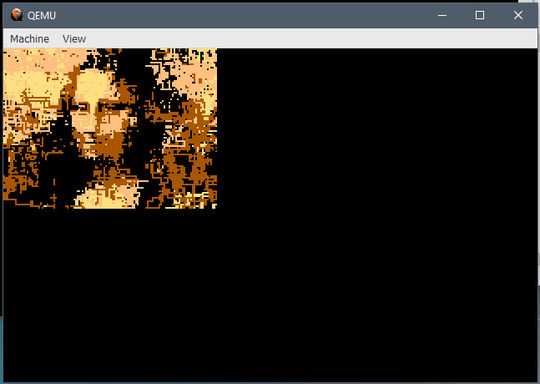
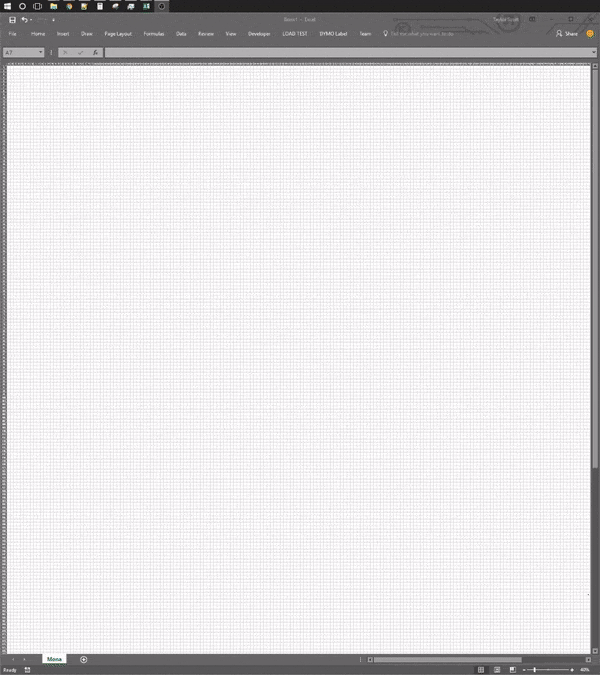

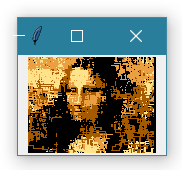
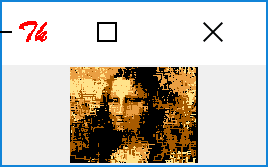
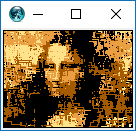



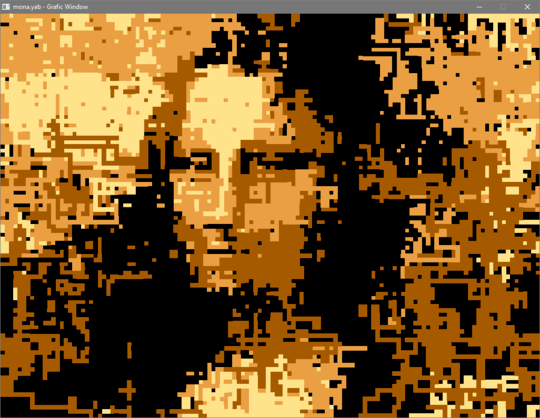
1The "you're encouraged to" is problematic, because if doing so conflicts with saving bytes, should someone do so or not? It should either be "you must" (do it even if it costs bytes), or "you may" (do it only if it saves bytes). – None – 2017-06-16T02:19:32.780
@ais523 You're right. I suspected it was wrong when I wrote it. This doesn't add much to the challenge anyway, so I've removed this point entirely. – Arnauld – 2017-06-16T02:25:42.513
1Usually I think it's better to split the ascii option into another challenge, otherwise there are kind of 2 sub-challenges anyway. – FryAmTheEggman – 2017-06-16T02:33:23.253
1@FryAmTheEggman It was originally meant to be graphical output only and adding this ASCII option was probably a bad idea indeed. Hopefully I'm not ruining some WIP answer by removing it... – Arnauld – 2017-06-16T02:47:56.650
Possible duplicate of Paint Starry Night, objectively, in 1kB of code
– ATaco – 2017-06-16T02:48:33.8974@ATaco Paint Starry Nigh was a code-challenge with a different goal (reproducing the image as closely as possible). This one is plain kolmogorov-complexity with a constant output. – Arnauld – 2017-06-16T02:57:23.973
1That's understandable, Redacting my close vote. – ATaco – 2017-06-16T03:10:02.617
I removed
AND 0xFFFFFFFFbecause it seemed to be wrong to me! – sergiol – 2017-09-03T01:22:57.0571@sergiol It's useless, but certainly not wrong. The original assembly code is doing
ASL crc_seed / ROL crc_seed+1 / ROL crc_seed+2 / ROL crc_seed+3 / BCC nofeedbackwhere each memory location is 8-bit wide. So it's limited to a 32-bit quantity by nature. The idea behind thisAND 0xFFFFFFFFwas to explicitly mimic this behavior. – Arnauld – 2017-09-03T08:05:17.803@Arnauld: Thanks for giving me clairvoyance. I just did the rollback. – sergiol – 2017-09-03T08:11:31.667
@sergiol I rolled back to revision #8 instead, because your note about bitwise operations is relevant. – Arnauld – 2017-09-03T08:14:50.753
I must have did a mistake when I did the rollback. I didn't want to rollback to version 7, but to 8. – sergiol – 2017-09-03T08:26:45.493
Has nobody else noticed that none of the answers exactly match the picture in the question? At least the ones that have included a screenshot. They look like they all might match each other, though, so maybe it's a mistake in the pseudo-code? – James Holderness – 2017-12-20T17:24:45.387
@JamesHolderness I've updated the picture to what the pseudo-code and the submissions are actually generating. There must be some subtlety in the original 6502 assembly code that I didn't translate accurately. :-( – Arnauld – 2017-12-20T21:05:07.717
Thanks @Arnauld. I'm busy working on an answer at the moment, and I was a bit worried that my results weren't matching up with the original picture. – James Holderness – 2017-12-20T22:05:29.630
It is possible for BX or BY to be above 127 sometimes, causing lines to be drawn outside the 127x127 area. Maybe they should be ANDed by 0x7F rather than 0xFF? But I don't actually see any differences in the original and the ones generated by answers here... – 12Me21 – 2018-03-05T18:47:40.230
using 0x7F instead of 0xFF seems to be adding more differences, so I don't think that's it. But maybe SOMETHING is happening to the stuff which is drawn out of bounds... – 12Me21 – 2018-03-05T18:53:29.470
FYI, This challenge was recently linked from this question from Retrocomputing.SE.
– user202729 – 2018-03-25T10:18:44.793Also, about "submitting the original 6502 code", I think that's "using someone else's code" and is disallowed by default. Or only as a CW. I'm not sure about that. – user202729 – 2018-03-25T10:19:06.630